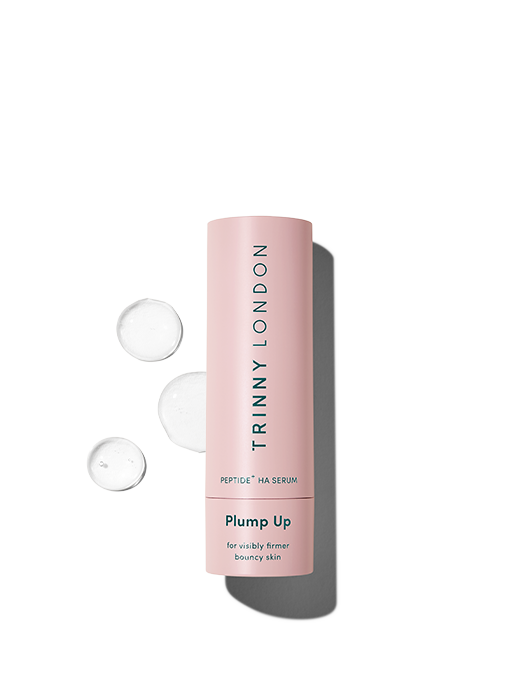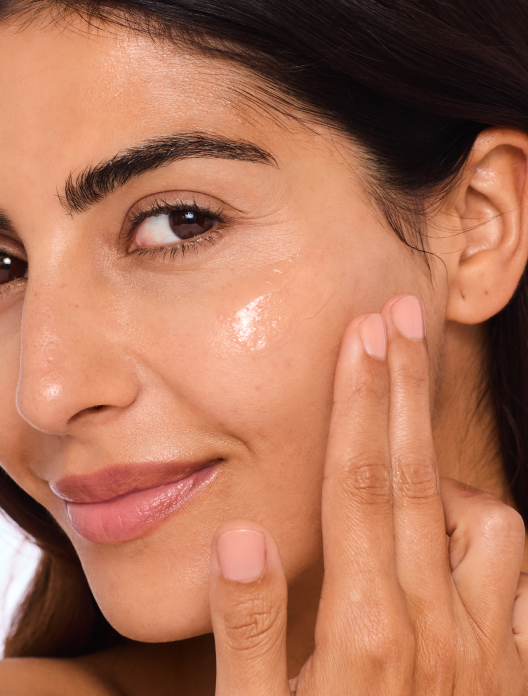

Plump Up
Peptide and hyaluronic acid serum for visibly firmer, bouncy skin, suitable for all skin types
Get a free Effortless Glow gift set when you spend $200*

To understand peptides, we need to think of them in relation to two other elements: amino acids and proteins. Peptides are short chains of amino acids that make up proteins like collagen and elastin. The body is made up of thousands of different proteins, each of which have a specific function. Collagen is the most abundant protein in the body, and makes up an impressive 75% of our skin.
These proteins, like collagen and elastin, are continuously being repaired and replaced throughout our lives. For this reason, we need a healthy stock of their building blocks (amino acids) to replenish them with. So where can we source them? Amino acids normally come from our diet through proteins. The body breaks them down back into amino acids, when it then reassembles them into new peptides and proteins. Think of it like remodelling the elements of old jewellery into newer pieces.
There is a difference between the way the body uses peptides, and how we use peptides in skincare. Peptides in skincare work to help restore proteins like collagen and elastin that deplete over time. They have benefits over complete proteins, which are too large to penetrate the skin, and amino acids, which aren’t as able to communicate specific messages.
Peptides can work in different ways, and convey different messages, depending on the specific combination of amino acids they’re made up of. To think of them in the context of Trinny London makeup stacks, one set of three products and shades will create a completely different look compared to three others.
There are four key types of peptide being used in skincare. It is worth noting that peptides are not necessarily one-trick ponies, and some can do more than one thing.
Signal peptides: which send messages to encourage the production of proteins like collagen and elastin.
Neurotransmitter inhibitor peptides: which help block the release of chemicals that cause the muscle contractions of expression lines. They work in a similar way to Botox to soften existing lines and prevent new ones from forming.
Carrier peptides: help to carry elements that help the formation of proteins (like collagen and elastin) to where they need to be.
Enzyme inhibitor peptides: help to prevent the breakdown of existing collagen and elastin.
Peptides always have the suffix “peptide” on the INCI list. For example, copper tri__peptide__ and acetyl hexa__peptide__. There are also trade names to look out for, such as Matrixyl. Some peptides use greek numbers as the prefix of the name (such as penta, hexa, hepta) to indicate the number of amino acids (five, six, seven) that have been combined to form this specific peptide.
When shopping for say, a vitamin C serum, you want to see the active ingredient sitting proudly close to the top of the ingredients list. For peptides, the opposite is true, and peptides will be listed much further down – even past the preservatives which don’t tend to be used above 1%. This is as the efficacy levels of peptides are very low, and you only need the smallest amount to make a big difference. Think of it like a powerful flavour, like truffle. As the numbers don’t sound very impressive (and to avoid formula copycats) brands don’t tend to share the percentage or concentration of peptides they use on packaging or in marketing materials. Something that’s really important with peptides is their delivery system, as this will determine whether or not they make their way into the skin. This is impossible to know unless the brand tells you about it. If you’re unsure whether or not to trust what a brand is saying, look out for results of clinical trials where products have been tested by experts in a controlled environment.
Peptides are generally considered to be non-irritating, and therefore can be well-tolerated by all skin types – even sensitive skin. This is mostly due to the fact that they don’t need to be used at an extreme percentage, don’t have a low pH and their mechanism of action doesn’t cause them to do things like speed up cell turnover (which can cause irritation). Peptides also already exist in the skin, so you’re not introducing something new, rather replenishing lost stocks or welcoming back an old friend.
Unlike other potent actives like retinoids and alpha-hydroxy acids, peptides won’t increase sun sensitivity so can be used at any time of day. For maximum opportunity to work their magic, they’re best used after cleansing or exfoliating and in a leave-on product like a serum or moisturiser. If you’re using a combination of serums, work in order of consistency, from lightest to heaviest, to give the lighter serums the opportunity to make their way into the skin.
Shop the article


Peptide and hyaluronic acid serum for visibly firmer, bouncy skin, suitable for all skin types